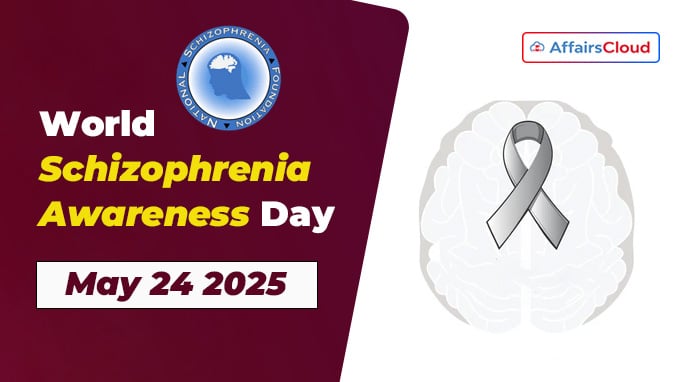 World Schizophrenia Awareness Day, also known as Pinel Day, is observed annually across the globe on May 24 to raise awareness about schizophrenia, a severe mental disorder affecting millions globally.
World Schizophrenia Awareness Day, also known as Pinel Day, is observed annually across the globe on May 24 to raise awareness about schizophrenia, a severe mental disorder affecting millions globally.
- The day aims to fight myths, reduce stigma and discrimination, promote mental health care, and support people living with schizophrenia.
2025 Theme:
The theme for 2025 World Schizophrenia Awareness Day is “Rethink the Label: Reclaim the Story”.
Note: There is no official theme announced for World Schizophrenia Awareness Day 2025, but the above theme is widely shared by news sites and mental health organizations.
Symbol for Schizophrenia:
The silver ribbon is the internationally recognized symbol for schizophrenia awareness. It represents clarity, strength, and the ongoing global effort to combat stigma and discrimination faced by individuals living with schizophrenia.
Background:
i.World Schizophrenia Awareness Day was established by the National Schizophrenia Foundation (NSF), a not-for-profit agency, this day honors Dr. Philippe Pinel (1745–1826), a French physician who pioneered humane treatment for mental illness.
ii.The date commemorates the day in 1792 when Dr. Pinel began to release psychiatric patients from chains at the Bicêtre Hospital in Paris(France), advocating for more humane treatment of the mentally ill.
iii.The term schizophrenia (Greek: schizein = splitting, phren = mind) was coined on 24 April 1908 by Swiss psychiatrist Professor Paul Eugen Bleuler.
Schizophrenia:
Schizophrenia is a chronic, severe mental disorder affecting thought processes, emotions, behavior, and reality perception. Key facts include:
i.Prevalence: Impacts around 24 million people globally (1 in 300 individuals or 0.32%). Among adults, the rate rises to 1 in 222 (0.45%).
- Schizophrenia is a major public health concern in India, currently affecting around 3.5 million people. Studies report a lifetime prevalence of 1.41% and a current prevalence of 0.42%, or 3 in every 1,000 individuals.
ii.Onset: Typically manifests in late adolescence or early adulthood (ages 15–35), with earlier onset in men. Men are twice as likely to develop it as women.
iii.Mortality: Patients face 2–3 times higher risk of early death, often due to cardiovascular or metabolic diseases linked to poor healthcare access.
Symptoms
i.Psychotic Symptoms:
- Hallucinations: Sensing unreal stimuli (e.g., hearing voices).
- Delusions: Fixed false beliefs (e.g., persecution fears).
- Disorganized speech or behavior: Incoherent communication or unpredictable actions.
ii.Negative Symptoms: Loss of motivation, diminished emotional expression, social withdrawal, and difficulty in daily functioning.
iii.Cognitive Symptoms: Problems with attention, concentration, and memory.
Treatment:
While no cure exists, effective strategies include:
i.Medication: Antipsychotics (e.g., clozapine) reduce psychotic symptoms in 70–80% of cases.
ii.Therapy: Cognitive Behavioral Therapy (CBT) helps manage symptoms and improve social functioning.
iii.Psychosocial Support: Rehabilitation programs, supported employment, and family interventions enhance recovery.
Global Challenges:
i.Over two-thirds of schizophrenia patients lack access to mental health care, worsening in low-income regions.
ii.Around 64.5% face discrimination, hindering social integration and healthcare access.
World Health Organisation (WHO) Initiatives:
i.Comprehensive Mental Health Action Plan (2013–2030): Adopted by the 66th World Health Assembly, this plan outlines steps to provide proper services for people with mental disorders, including schizophrenia.
ii.Special Initiative for Mental Health: Aims to provide 100 million more people access to affordable care by 2030.
iii.Mental Health Gap Action Programme (mhGAP): Deploys evidence-based tools in 100+ countries, prioritizing psychosis management in resource-poor settings.




